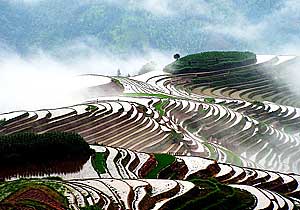Longji Rice Terraces

It is said of Longji, "Where there is soil, there is a terrace."
The Dragon's Backbone Rice Terraces (Longji) are the most famous rice terraces in China and are truly a must-see for anyone visiting Guangxi. The unusual name comes from their so called resemblance to a Dragon's scales. Considered the best rice terraces in China, they are located about 100 km from Guilin in Longsheng County and are sometimes called Longsheng terraces. Truly a feat of human engineering, the Longji terraces were built by the minority Zhuang and Yao people between the Yuan Dynasty (1271-1368) and Qing Dynasty (1644-1911). Standing between 300m and 1100m the terraces carved into the hillsides cover a huge area of 66 square kilometers.
Visiting Longji is an opportunity to witness some culture of the Zhuang and Yao minorities. When touring Longji you usually begin in one of two villages – the Zhuang village of Ping'an and the Yao village of Dazhai. The two villages are 4 to 5 hours walk away from each other and connected by long passways. People usually follow the routes recommended by Guilin's travel agencies and choose one of the two major scenic areas to spend their time.
Ping'an village is in the Ping'an terraces and is traditionally the most common starting point of visiting the scenic area. This has accommodation and restaurants and you can experience some Zhuang customs such as their singing and dancing, as well as every subtle details of the people's distinctive way of living. The less common starting point is Dazhai village in the Jinkeng terraces. It is more remote, and takes another half an hour drive from Ping'an to go deeper. This area is a Yao minority habitation and now attracting much more travelers than before.
Between Ping'an and Dazhai there is a large network of flagstone pathways and roads leading up and around the terraces. There are many different vantage spots to admire the terraces beauty and you can see some more small minority villages on your trek. Be prepared though as the trek can be strenuous and long with a lot of uphill walking. 4-6 hours is normal.
The best time to visit the terraces is said to be in late spring or autumn. Every year after April 15 of Chinese lunar calendar (mid to late May) farmers begin to irrigate the field which brings an amazing view of terraces sparkling with water; and in autumn, usually around the Mid-Autumn Festival (late September to early October) you are blinded by a stunning gold landscape as the rice is ready to be harvested. This is merely opinion, however, as summer brings a beautiful vibrant green color to the terraces as the rice stalks are growing and winter a blanket of snow.